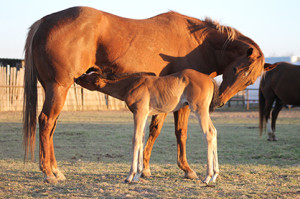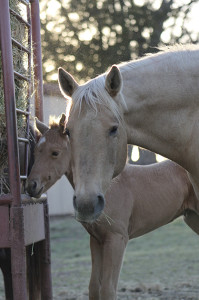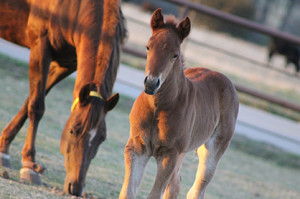Breeding Season Prep Basics: Mares
By: Megan Arszman
If you have a mare you’re planning on breeding this year, you’ve probably already started preparations well in advance—after all, there are stallions to choose from and contracts to sign. But what about the physical work with your mare? Is she ready?
Every breeding season should start with a breeding soundness exam. As stated earlier in Breeding Season Prep Basics for Stallions, tests for venereal diseases should be performed as part of these exams. Mare owners should be aware of any presence of contagious equine metritis, equine viral arteritis, and any threats of embryonic death.
For mares, the breeding soundness exam will involve looking at the ovaries, uterus, and cervix, as well as using an ultrasound machine. Your veterinarian will do an endometrial swab of the clitoris and the uterus for signs of any bacteria present or signs of inflammation of the uterus (endometritis). In some cases, a uterine biopsy might be conducted to help decide if it’s worth trying to breed the mare; a mare with a lot of scar tissue in the uterus will have a poor chance of conceiving.
The Maiden Mare
Maiden mares might need a little more patience both in and out of the breeding shed than the experienced broodmare. Some experts say the ideal age for a maiden mare is between four to seven years, but a lot of show mares are just starting to hit their peak at those ages. If you’re waiting until your mare is older than seven, it’s important to work with your veterinarian as soon as you decide it’s time to start her second career as a mother.
Keeping track of your maiden’s heat cycles is important, and it helps to have your mare at the breeder a little ahead of time, so they can start working with a teaser. A maiden mare might not be as forthcoming with her heat or welcoming to the teaser, especially if she just recently came off the show trail.
The Older Mare
As the mare ages, her fertility starts to decline when she hits her teens. Elaine Carnevale, DVM, PhD, associate professor at Colorado State University, states the obvious when it comes to helping the older mare carry a foal full-term.
“If you want the mare to carry the foal, make sure she is able to carry the foal. The older broodmare is tough,” she says. “Some mares have a baby every year and seem quite capable of doing it. But when you get to those older mares, you need to make sure that their uterus is alright to carry the foal, and that usually involves a biopsy and/or ultrasound scan.”
Working with your reproduction specialist will help ensure that you’ve got a good egg from the mare. Dr. Carnevale also recommends looking at younger stallions for their more viable semen when it comes to breeding your older broodmare.
Gut Check
Just as with humans, researchers are looking into the effect weight has on mares and how the extra pounds affect fertility and the ability to carry a foal to term.
“It’s a big problem now with humans, and they’ve shown that ovulatory problems are more prevalent when the mare is overweight,” Dr. Carnevale says. “There are a lot of things changing when a mare is overweight or has a metabolic syndrome. It can affect fertility, but the scary thing is that it can affect their offspring, and potentially their offspring’s offspring, if we go by the studies of other species.”
Keeping your mare at a healthy weight via exercise and diet will help increase her chances of carrying a healthy foal to term.













